One of the five Māori carvers who have combined kiwifruit vines and symbolic motifs from the area of Tauranga, said their carving is called "Te Aka Thuone", i.e. "the orchard that unites us".
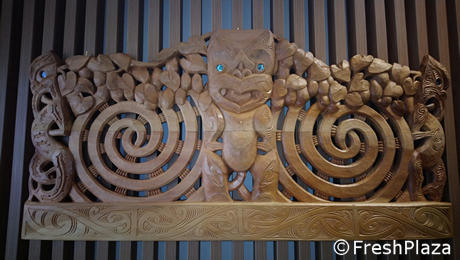
The carving was made using Kauri wood with Paua, the abalone mother of pearl. It symbolizes the fusion between the two hemispheres. Zespri's corporate hymn in the Māori language also talks about cohesion and unity. This is because the largest New Zealand company growing and trading kiwifruits has also been working on the other side of the world, in Italy, to maintain their brand available twelve months a year.
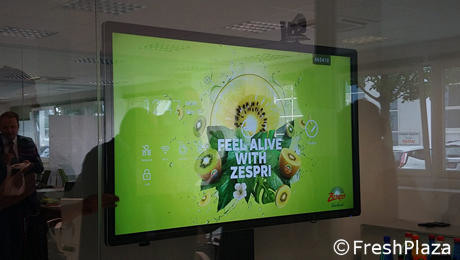
To make this possible, Italian and New Zealand producers must meet many times. This time, it was the Māori delegation that traveled half way across the world.
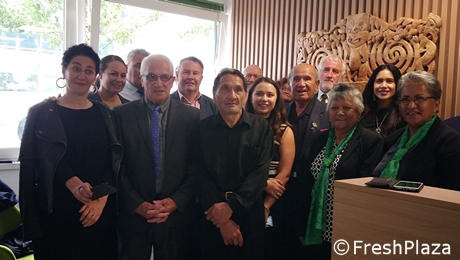
The delegation visited Italy between 16th and 20th May on the occasion of the commemoration of the Battle of Cassino occurred in 1944. On 18th and 19th May, the group visited the vineyards and orchards in Cisterna di Latina while, on the 20th, it moved to Bologna for the inauguration of the new Zespri facility and visited local warehouses and supermarkets.
A moment during the visit of Māori producers to orchards in the Latina province. A great occasion to share knowledge and establish fruitful relations for the future.
The carving was unveiled during a touching ceremony and will decorate the new Zespri facility in Bologna inaugurated on 20th May, "a clear sign of how the sector has recovered after the Psa issue," explained Dario Vegetti, Supply Chain Manager for Zgs Europe, Zespri Global Supply.
In four years, the company has gone from 15 to 40 employees and "volumes processed have also grown. SunGold alone have increased by 80% with the 2018/19 harvest," adds Vegetti, also recalling the role that Cso Italy, Centro Servizi Ortofrutticoli, Fruitimprese and the four POs have played in Zespri's success in Italy.
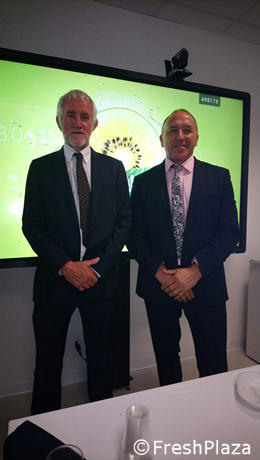 "While the office in Latina is useful for producers, Bologna is a strategic place to support our post-harvest partners. Our objective is to keep on growing. Harvesting has just ended in New Zealand and the year was excellent as the fruit had a high dry matter content. We are thrilled with the opportunity of selling our produce in Europe, as the quality of our kiwifruits is extremely high," explained Paul Jones, Zespri vice-president.
"While the office in Latina is useful for producers, Bologna is a strategic place to support our post-harvest partners. Our objective is to keep on growing. Harvesting has just ended in New Zealand and the year was excellent as the fruit had a high dry matter content. We are thrilled with the opportunity of selling our produce in Europe, as the quality of our kiwifruits is extremely high," explained Paul Jones, Zespri vice-president.
In the photo: Paul Jones, Zespri vice-president and Pita Tipene, President of Ngati Hine
The brand, owned by 2500 New Zealand growers, is also known for its excellent R&D program. Zespri kiwifruits are cultivated in New Zealand, Italy, France, Japan and Korea and exported in over 50 countries worldwide.
Katiakitanga: the Māori blessing of all of the facility's walls with a small procession of Aboriginal growers among the desks where they performed their most famous dance, the Haka.
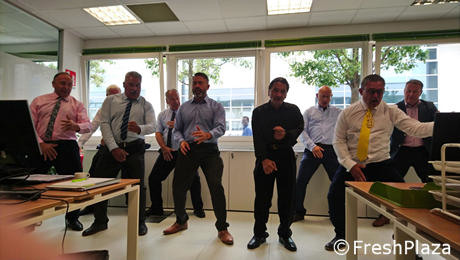 A moment during the Haka.
A moment during the Haka.
"The Māori are a very important part of New Zealand production and Zespri culture." 12% of its shareholders-producers are Māori and "Katiakitanga means being guardians of the environment and of the land. It is one of the values we borrow from the Māori to do business. Another is their long-term vision: when they make a plan, it reaches from their forefathers to the future generations with the objective of safeguarding the environment and the people."
"Our genetic improvement programs led to the creation of our most successful variety - SuhnGold. We continue investing a lot to find new superior qualities, but our varietal development program only employs natural GMO-free methods."
Pita Tipene, chairman of Ngati Hine, reports that "30% of the Māori population works in the agricultural sector, especially in northern New Zealand where our people controls the land. 15% of Zespri producers and shareholders are Māori and cover 10%of the production, but we aim at reaching 20%. Even though only 5% of the production is organic, the trend is growing and safeguarding the environment is our top priority."
"The visit to Cassino, where our ancestors have died and suffered for the freedom of the Italian people during the Second World War, made us emotional," concluded Tipene explaining that the 28th Māori battalion took part in the heroic defense of Cassino against the German paratroopers in 1944. 400 died and 1200 were wounded. 75 years later, their Haka resounded also in the British cemetery at the bottom of Monte Cassino. Almost everyone in the delegation had a relative who fought in the battle.
From a professional point of view, the purpose of the trip was to "strengthen the relationship between producers, consumers and the Zespri staff. We use the same cultivation techniques, but the Māori have a different relationship with the land. I have noticed some similarities between us and the producers we have met in Cisterna: fathers, sons and grandsons welcomed us - an intergenerational approach that we share."
Author: C.A. for FreshPlaza
